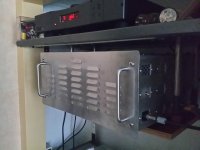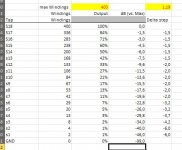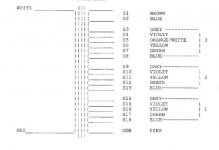This is awesome!
As I have read your posts regaring the brick wall of 30 boards, it got me a bit thinking, would it be possible then instead of 2x16 which doet not work as you experienced, to make a 4x8 configuration? Have you thought about this also? Could that work?
It probably would work on SPDIF input but the splitting up the I2S from the Wave IO board would be too much for it to work, more main boards would be needed also.
I am going to leave it alone now and listen to some CD`s as it sound very good now and maybe better after some settling in time
It probably would work on SPDIF input but the splitting up the I2S from the Wave IO board would be too much for it to work, more main boards would be needed also.
I am going to leave it alone now and listen to some CD`s as it sound very good now and maybe better after some settling in time
Keep in mind that every blue board has an i2s buffer before the signal goes to the DAC modules... Therefore it does not matter what source you take. I guess the waveIO would be able to drive 4 main boards
But these are just thoughts, I would not suggest to start immediate building
In case four DIY would come together and have fun in trying it would be a nice experiment of course... Like I did with the 240 DAC in parallel experiment. After that no one actually start building and using that of course, but it was a nice hobby thing to do
I might have a spare board soon so just wanted to check if there is anyone who has made a 5 deck DAC configuration? Have some questions related to the 5 deck version :
- Will the 12V power supply be able to drive 5 boards? Or would be require a high voltage PSU?
- What will be the values of the Rload resistors to be put in the Ra & Rb positions in 5 deck version?
- Will it have any positives in terms of sound quality when compared to a 4 board version?
- I will also be adding in Cinemags in place of capacitors in the output, will a 5 deck version be fine to be coupled with the Cinemags?
Cheers
Kartick
Any reverts will be helpful. Thanks.
Any reverts will be helpful. Thanks.
Voltage should always be 12-12,5 Volt regardless of number of decks.
Normal power supply can do max 1A (as for heatsinks...) so 5 boards of first version is no problem. The new tent shunt version can only be 4 boards when the power supply is stock. 5 Boards will draw aprox 1,1 A so it is very close. so if you increase the fuse and add some extra cooling it might work. But to be honest, I would increase the sizen of the transformer (more VA) as well doing this
Ra & Rb: The combined value of Ra // Rb should be 133/5 = 26,6. Ergo stock 27 Ohm will do the Job nicely. Power rating need to be 1Watt
SQ: well, as you "only" add one board it might be minimal. Just try and say for your self I would say
The more decks, the better the low frequency Response from the transformer (this is a general rule...) so answer is yes
Hello,
The dddac community did go into deep hibernation. Or is it breaking down like the good old EU?
This design really takes some time to settle down. The details are there within an hour but some cd will sound strident the first days! Especially female voices can sound like their is no body attached to the vocal chords. acoustic guitar sounds not like made of wood but more like a metal one. Cannot understand why people start raving just after a few minutes. Maybe they are not used to a good dac?
Maybe the Sowter transformers need some time to give their best.
maybe people want it to sound good right away, after all the investment is not that small?
Just build it and dont judge to quickly!
greetings, eduard
The dddac community did go into deep hibernation. Or is it breaking down like the good old EU?
This design really takes some time to settle down. The details are there within an hour but some cd will sound strident the first days! Especially female voices can sound like their is no body attached to the vocal chords. acoustic guitar sounds not like made of wood but more like a metal one. Cannot understand why people start raving just after a few minutes. Maybe they are not used to a good dac?
Maybe the Sowter transformers need some time to give their best.
maybe people want it to sound good right away, after all the investment is not that small?
Just build it and dont judge to quickly!
greetings, eduard
I am going to declare that my DDDAC journey is now over
30 Dac boards total with the following alterations:
All electrolytic capacitors Nichicon Polymer FPCAP 50v as I leave the Dac powered up permanently.
The 6k pin 20 resistor is a Charcroft S102J 0.1% for stability and low noise level.
I had a pair of 1-1 Sowter transformer made as I do not need the high output voltage and probably gained a little but of bass slam into the bargain
The IV conversion once again Charcroft resistors are the CE-VSR6 for the extra dissipation.
I was hoping for 32 Dac boards total but I fell foul of the I2S maximum length rule ... so 15 standard boards each side seems to be the maximum.
I did try the Tent powered boards at the top of each stack but the I2S problem reared up again so off they came and replaced them with the standard ones and all is OK.
It would be an interesting experiment to see how many Tent boards could be driven by the main board but I really must stop somewhere.
Only thing now is the fact I have one Blue main board, two powered by tent Dac boards built and tested and current source set at 40mV, and a pair of the standard Dac boards going spare ...
Also have my original 16 standard board DDDAC with an uprated power supply although it is SPDIF only as I used the WaveIO board in the 30 stacker ...
Was it worth the longs journey ?
Hell yes , I have never heard reproduced music so lifelike and I am only using SPDIF.
By stacking the boards, the stereo image just gets better the more stacks you put together.
The stereo effect now is just as good as pair of expensive headphones, it seems to lock all the sounds together into a coherent whole and provide a solidity to percussion that has the be heard to believe what is possible.
The USB is working fine so now I will have to experiment with Hi Res but I am very impressed what 44.1 sample rate can do with a top flight Dac.
Wow props mate that is one crazy build well done bet it sounds amazing! [emoji3]
Sent from my 486 IBM WIN 3.1x Desktop...
Hello,
The dddac community did go into deep hibernation. Or is it breaking down like the good old EU?
This design really takes some time to settle down. The details are there within an hour but some cd will sound strident the first days! Especially female voices can sound like their is no body attached to the vocal chords. acoustic guitar sounds not like made of wood but more like a metal one. Cannot understand why people start raving just after a few minutes. Maybe they are not used to a good dac?
Maybe the Sowter transformers need some time to give their best.
maybe people want it to sound good right away, after all the investment is not that small?
Just build it and dont judge to quickly!
greetings, eduard
I have few suggestions, one of which I already posted before... remove everything from that metal cage, made of profiles and braces, and place it on a piece of wood.
Use MSR860G as rectifier diodes.
Decoupling capacitors can also be changed to smd, but choosing the right one with correct sound signature is tricky and will depend on the rest of equipment, and if you are willing to do the first two suggestions.
Nick
Has anyone implemented a preamp/volume control in their build with the DDDAc would love to hear what you used, any details and how you found results
Sent from my 486 IBM WIN 3.1x Desktop...
I am still using the (special dddac) Sowter Transformers with taps at the output. So being a TVC
I am still using the (special dddac) Sowter Transformers with taps at the output. So being a TVC
Thanks DDD Interesting, admittedly somewhat new to DIY so not entirely sure how yours works
Sent from my 486 IBM WIN 3.1x Desktop...
Thanks DDD Interesting, admittedly somewhat new to DIY so not entirely sure how yours works(forgive me newbieness ) eagerly awaiting my DDDAC to arrive for my first build
hoping to get some feedback/advice on volume control..
Sent from my 486 IBM WIN 3.1x Desktop...
Check the pdf, I think it tells it all.
Every tap stands for a number of windings (my spec) which than delivers a different ratio for the input/output voltage. It is designed so, it is a ladder with certain dB steps which make sense as a volume control.
Normal pots or rotary switch volume Controls have the significant disadvantage that in the middle volumes the output impedance is relatively high which is not good driving cables (RC filter)
With a transformer this is of course NOT the case. In fact at every step of lower volume the performance of the Transforming ratio increases thanks to less windings. Output impedance gets also lower with every step. VERY good for driving cables.
But maybe it gets to technical again, sorry…
Attachments
Check the pdf, I think it tells it all.
Every tap stands for a number of windings (my spec) which than delivers a different ratio for the input/output voltage. It is designed so, it is a ladder with certain dB steps which make sense as a volume control.
Normal pots or rotary switch volume Controls have the significant disadvantage that in the middle volumes the output impedance is relatively high which is not good driving cables (RC filter)
With a transformer this is of course NOT the case. In fact at every step of lower volume the performance of the Transforming ratio increases thanks to less windings. Output impedance gets also lower with every step. VERY good for driving cables.
But maybe it gets to technical again, sorry…
Thanks DDD appreciate you taking time to reply. Might drop a line to Marco and can discuss the options prior to him shipping mine
Sent from my 486 IBM WIN 3.1x Desktop...
Has anyone implemented a preamp/volume control in their build with the DDDAc would love to hear what you used, any details and how you found results
I am in the process of building a TVC control with 27 relay switches that are controlled by an Arduino microcrontroller. It's intended to work my Sowter 9335 transformer, but other transformers will also work. Doede already tested the 9335 on his AP analyzer with the DDDAC, and it performed very well.
I built the first prototype on a perf board (which was a major PITA), and that seems to work well. In the end, the whole thing is intended to live on two PCB "decks" that are stacked on each other, and are plugged onto the Arduino. The overall concept is very similar to Doedes design, but without source selection (and I believe it will be physically smaller).
I am currently waiting to receive the first PCB boards for the firsd "deck" that will deal with relay switches 1-14. Once I get this working, I will finish the second board. In the end I will probably have some extra boards because OshPark wants me to order at least three boards.
Hello All - I had a very interesting email correspondence with Doede this morning. I put forward a question to him and he was gracious enough to take it sportingly and even encouraged that I can put it across to all of you here on the forum.
I am using the DDDAC from last 4 years. But I have been very interested to find out from others that how do they find the DDDAC vs some of the other coveted commercial DACs available such as the ones from Chord or Schiit Yggdrasil? Is there anyone who has used other high end dacs, share their impressions here?
I am using the DDDAC from last 4 years. But I have been very interested to find out from others that how do they find the DDDAC vs some of the other coveted commercial DACs available such as the ones from Chord or Schiit Yggdrasil? Is there anyone who has used other high end dacs, share their impressions here?
I am using the DDDAC from last 4 years. But I have been very interested to find out from others that how do they find the DDDAC vs some of the other coveted commercial DACs available such as the ones from Chord or Schiit Yggdrasil? Is there anyone who has used other high end dacs, share their impressions here?
I was a big fan of DDDAC! Spent exceedingly more than $8,000, without considering the invested effort/time, for my build to date. Have also tried many others' commercialised DAC and found DDDAC is the most natural DAC there is, until I found Accuphase DC-37.
DC-37 does DSD remarkable well and simply has better noise ratio compare to my DDDAC build.
Please note this is a personal opinion, might not be applicable to all. Nonetheless, get out there and auditions many as possible instead of inhale the soldering fumes..!
Sent from my iPhone using Tapatalk
I was a big fan of DDDAC! Spent exceedingly more than $8,000, without considering the invested effort/time, for my build to date. Have also tried many others' commercialised DAC and found DDDAC is the most natural DAC there is, until I found Accuphase DC-37.
DC-37 does DSD remarkable well and simply has better noise ratio compare to my DDDAC build.
Please note this is a personal opinion, might not be applicable to all. Nonetheless, get out there and auditions many as possible instead of inhale the soldering fumes..!
Sent from my iPhone using Tapatalk
Surely it all depends on the DAC chip. For any DIYer the rest is do-able. So naturally what chip does the Accuphase DC-37 use
The rest is merely the same requirement to support this chip with the best LCR, and using ultra low noise regulated power supplies in all the key areas.
Surely it all depends on the DAC chip. For any DIYer the rest is do-able. So naturally what chip does the Accuphase DC-37 use
The rest is merely the same requirement to support this chip with the best LCR, and using ultra low noise regulated power supplies in all the key areas.
Not disagree whatsoever. For the clarity I did extensively compare both DACs on my identical setup as I am owing them both. Mind you I have invested in DDDAC with love and funding were never an obstacle. Deep down I wanted DDDAC to be the better, but among all DACs I have experienced in my audio room first hand, this Accuphase DC-37 was better. We also did a shoot out between Accuphase DC-37 vs Gryphon Kalliope, recently too.
Here is the infor for Accuphase DC-37:
http://www.stereo.net.au/forums/index.php/topic/75894-accuphase-dc-37-dac-first-outside-of-japan/
Here is the shoot out we did between DC-37 vs Kalliope:
http://www.stereo.net.au/forums/ind...share_tid=106735&share_fid=46070&share_type=t
Apologies for the off-topic.
- Home
- Source & Line
- Digital Line Level
- A NOS 192/24 DAC with the PCM1794 (and WaveIO USB input)


